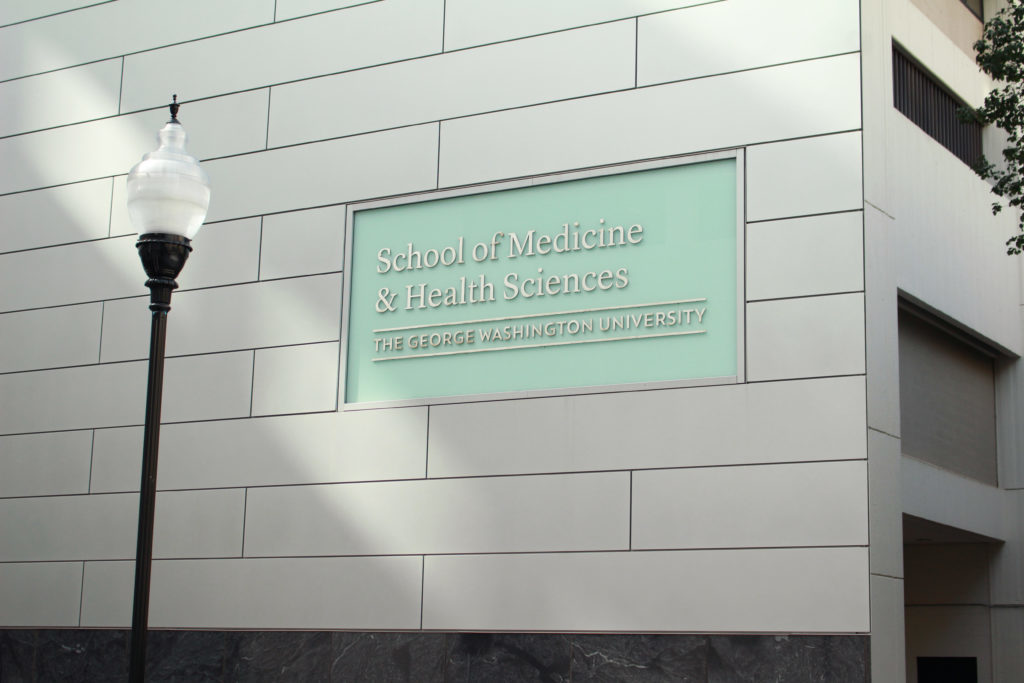Updated: Sept. 13, 2019 at 5:13 p.m.
A “report card” published Monday gave the School of Medicine and Health Sciences a B- on racial diversity, equity and inclusion efforts.
Medical students collaborated with White Coats for Black Lives – a student-run organization that aims to eliminate racial bias in medical education and clinical practices – on a report detailing how the medical school handles issues related to racial diversity based on 14 metrics. Officials and students who worked on the report said the medical school has made “significant” strides toward bolstering diversity and inclusion initiatives but needs some improvements.
The report shows that the medical school lacks faculty and student diversity and needs to incorporate the history of racism in medicine into classroom teaching. Grace Henry – the medical school’s director of diversity and inclusion who worked with students on the report – said the report “affirms” the office’s commitment to foster an “inclusive and diverse community.”
“Our focus is to ensure that no matter how you identify, you feel like SMHS is a place that not only welcomes you but values you,” Henry said in an email.
Henry said medical school curricula address how social factors, like unequal health care access and racism, in the medical field impact the health of communities of color. The medical school curricula have undergone “sweeping changes” in recent years, but education on the influence of racism on medicine is “lacking,” the report states.
Henry said the medical school committee that reviews the undergraduate medical education curriculum recently approved a document outlining guidelines on the use of race and ethnicity in medical school curricula. She said the document details how medical school classrooms can discuss the connection between race and health in a manner that is evidence-based and “relevant” to clinical decision-making.
“We recognize the history of racism in this country, and the impact it has had on medicine,” she said.
Henry said the school’s Office of Diversity and Inclusion will launch a student diversity council this fall in which students will provide feedback to officials on how to incorporate race into medical school curricula.
She declined to clarify how medical school officials respond to reports of racist incidents and what resources currently exist for minority students, pointing to resources in the Office of Diversity and Inclusion open to all students. Henry said all medical students can utilize the “Listening Post,” an online tool where students can submit feedback about the school.
The report states that the medical school student body is comprised of roughly 9 percent African American students and about 3 percent Latinx students. About 8 percent of medical school faculty are African American and roughly 4 percent are Latinx. Of the total U.S. population, 13 percent is African American, and 17 percent is Latinx.
The authors of the report said the Colonials moniker should not be present at medical school events, citing calls during last year’s Student Association elections to change the nickname.
The report’s authors urged the medical school to include portraits of notable faculty and alumni from groups underrepresented in the medical field in Ross Hall and the Himmelfarb Health Sciences Library.
Students in the medical school’s social justice interest group, which submitted the data for the report, said they assessed the medical school’s performance based off of White Coats for Black Lives’ recommendations for fostering an anti-racist culture.
The students said they collaborated with the medical school’s Office of Diversity and Inclusion for about a year to collect data for the report and submitted their assessments to the White Coats for Black Lives’ national working group in April.
Anjalie Subramanian, one of seven medical student contributors to the report, said increasing diversity among medical students will improve the quality of care that patients of color receive.
“Diversity in medical education, as in the rest of society, is critical as each student brings their unique lived experience with them, not only broadening our ability to relate to patients, but also ensuring that the conversations that take place in medical education are representative of many points of view,” Subramanian said in an email.
Rose Milando, another student contributor, said students pursuing careers in medicine must educate themselves about the relationship between racism and medicine to mitigate the “societal sickness” of racial injustice – defined in the medical field as the equal treatment of patients and doctors in medical settings.
She added that increasing medical faculty and students’ knowledge of racial inequities in medicine could make them more conscious of latent racial bias, which can ultimately mitigate the influence of racism on health care.
“We can advocate for patients to get the treatment they need, and we can check that our biases aren’t leading to disparate standards of care,” Milando said in an email.
Olamide Akin-Olugbade, another student contributor, said the medical school has made “significant strides” in recruiting more diverse faculty and creating a supportive community for students, but the school’s student and faculty populations still need more minority representation.
“There is still more work to be done with regard to minority representation in imagery around the school as well as within the student body and faculty,” Akin-Olugbade said in an email.
Shannon Mallard contributed reporting.
This post was updated to correct the following:
The Hatchet incorrectly reported that the report was published Tuesday. It was released Monday. The Hatchet also incorrectly attributed information to Henry instead of the report. The attribution has been corrected. We regret these errors.




